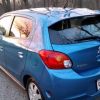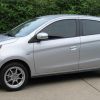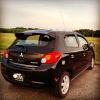If you're getting hardcore, you can do lighter brake rotors, axles, driveshafts... crankshaft. Anything that rotates can be lightened.
Ever heard of aluminum or carbon fiber driveshafts on RWD cars? That's a good one.
But, everything is a compromise. Lighter often means more fragile. They get away with it on an aluminum driveshaft by making it a larger diameter to tolerate the same torque as a steel driveshaft. But, they can be very "tin can" like. If you get a dent in a thin-walled aluminum driveshaft, it can crush and twist just like a soda can.
Brake rotors are another one. If you look at purpose built autocross cars, you will occasionally see things like seriously swiss-cheesed rotors. They'll fit the smallest brakes they can (opposite of the usual performance trend towards larger brakes) and then mill the rotors to minimum thickness and drill them full of holes. Net result is a brake rotor that weighs half as much as the original. They can get away with it because an autocross run is usually only 40-60 seconds long, and you only brake hard a couple times. So, the brakes don't have time to get overheated. Even with very little mass left to absorb the heat. But, if you tried to do the same thing on a track car, you'd only be good for maybe one lap around the track before smoking your brakes! And if you did it on the street, you'd likely get into serious pad fade after just a few "moderate" stops. But, for an all-out autocross car... it works.

You can get aluminum or titanium lug nuts. (but, you have to be SUPER careful about keeping them clean and torquing them properly)
Lightweight pistons and connecting rods, and subsequently lightened counterweights on the crankshaft.
It's always a constant battle between strength, weight, durability, and cost. Stamped steel and cast iron are always the cheapest, and generally very strong and durable... but, aluminum and other materials can be significantly lighter... at greater cost.



 Speck
Speck
 Reply With Quote
Reply With Quote
 Underdog
Underdog 2014 Mitsubishi Space Star (Mirage) 1.0L
2014 Mitsubishi Space Star (Mirage) 1.0L



 Puttster 2
Puttster 2
 Basic
Basic
